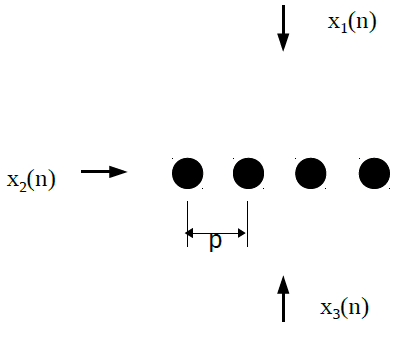Uniform sampling has aliasing problem. How about we sample a signal in a non-uniform fashion? It is fairly easy, actually it is more nature to position multiple microphones in a non-uniform or random positions. This short section discuss some of the interesting issues with non-uniform sampling that are useful in understanding microphone positioning problems.
Similarly, a microphone array has the same effect on traveling sound waves in space. In stead of describing the theory in the mathematics, we use the following simple diagram to show the concept.

The above diagram shows a linear microphone array with 4 omni-directional microphones. The inter-mic distance is p. It is easy to see that the linear microphone array cannot tell apart a signal from the right north or from the right south. However that is not the ambiguity we are interested in.
As shown in the diagram, we have a sound x1(n), impinging on the linear array from the broadside direction, and another sound source x2(n), from the left-side direction. We will examine the conditions that may cause ambiguity in the incoming directions.
If x2(n) is a monochromatic tone with wave length exactly p. The contribution from x2 will be the same on all microphones at all time. Regardless what signal x1(n) is, the microphone array will not be able to tell if x2(n) is present or not. Hence, there is a direction finding limitation that is related to the wavelength.
From time domain sampling theory, we know that at minimum two samples are needed to perfect reconstruct a waveform. The same applies to microphone array. Therefore, to avoid direction finding ambiguity we must have
2p < ג
or
f < v/(2p)
where v is the velocity of sound, ג is the wavelength of the sound, f is the frequency. Therefore, the maximum frequency this linear array can handle without ambiguity in direction finding is v/(2p), which is the spatial aliasing frequency.
Large separation between microphones is needed to detect low frequency contents but small distance is required to address spatial aliasing. This is the dilemma the microphone array technology is facing. At this time, state-of-the-art algorithms have only limited success in performing speech enhancement or 3D audio direction finding and reconstruction. VOCAL technologies employs microphone array technologies mainly for noise and interference reduction.